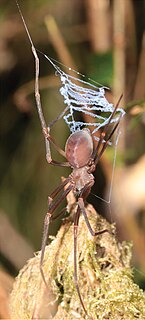
Ground spiders comprise Gnaphosidae, the seventh largest spider family with over 2,000 described species in over 100 genera distributed worldwide. There are 105 species known to central Europe, and common genera include Gnaphosa, Drassodes, Micaria, Cesonia, Zelotes and many others. They are closely related to Clubionidae. At present, no ground spiders are known to be seriously venomous to humans.

Dictynidae is a family of cribellate, hackled band-producing spiders first described by Octavius Pickard-Cambridge in 1871. Most build irregular webs on or near the ground, creating a tangle of silken fibers among several branches or stems of one plant.

Zygoballus is a genus of jumping spiders found in North and South America.

Cribellum literally means "little sieve", and in biology the term generally applies to anatomical structures in the form of tiny perforated plates.

The Agelenoidea or agelenoids are a superfamily or informal group of entelegyne araneomorph spiders. Phylogenetic studies since 2000 have not consistently recovered such a group, with more recent studies rejecting it.
The Dictynoidea or dictynoids are a group of araneomorph spiders that have been treated as a superfamily. The composition of the group has varied. Phylogenetic studies in the 21st century have failed to confirm the monophyly of the dictynoids as originally defined.
Saltonia is a monotypic genus of North American cribellate araneomorph spiders in the family Dictynidae containing the single species, Saltonia incerta. It was first described by R. V. Chamberlin & Wilton Ivie in 1942, and has only been found in United States. Originally placed with the funnel weavers, it was moved to the Dictynidae in 1967.
Elizabeth Bangs Bryant was an American arachnologist. She worked at the Museum of Comparative Zoology in Cambridge, Massachusetts and was a close acquaintance of James Henry Emerton. She is best known for her studies of the spiders of New England and the Caribbean.

Larinia is a genus of orb-weaver spiders first described by Eugène Simon in 1874.

Desis marina, the intertidal spider, is a spider species found in New Zealand, New Caledonia, and the Chatham Islands.

Alireza Zamani is an Iranian arachnologist and taxonomist.
Devade is a genus of cribellate araneomorph spiders in the family Dictynidae, and was first described by Eugène Simon in 1884. Originally placed with the Amaurobiidae, it was moved to the intertidal spiders in 1983, then to the Dictynidae in 1989.

Ohlertidion is a genus of comb-footed spiders that was first described by J. Wunderlich in 2008. As of September 2019 it contains three species with a holarctic distribution, including Greenland: O. lundbecki, O. ohlerti, and O. thaleri. A 2019 genetic study proposed to synonymize this genus with Heterotheridion; however, the evidence was based predominantly on COI barcoding, which is a useful tool for separating species, but is less useful for determining higher taxa.

Rhomphaea is a genus of comb-footed spiders that was first described by Ludwig Carl Christian Koch in 1872.
Asiascape is a monotypic genus of Middle Eastern funnel weavers containing the single species, Asiascape parthica. It was first described by Alireza Zamani and Yuri M. Marusik in 2020, and it has only been found in Iran.
Persilena is a monotypic genus of Middle Eastern funnel weavers containing the single species, Persilena sengleti. It was first described by Alireza Zamani and Yuri M. Marusik in 2020, and it has only been found in Iran.
Persiscape is a genus of funnel weavers first described by Alireza Zamani and Yuri M. Marusik in 2020.
Sestakovaia is a small genus of liocranid sac spiders first described by Alireza Zamani and Yuri M. Marusik in 2021. As of December 2021 it contains only two species: S. annulipes and S. hyrcania.
Bosselaerius is a genus of Asian spiders in the family Phrurolithidae. It was first described by Alireza Zamani and Yuri M. Marusik in 2020. As of March 2022 it contains only three species: B. daoxianensis, B. hyrcanicus, and B. tajikistanicus.









